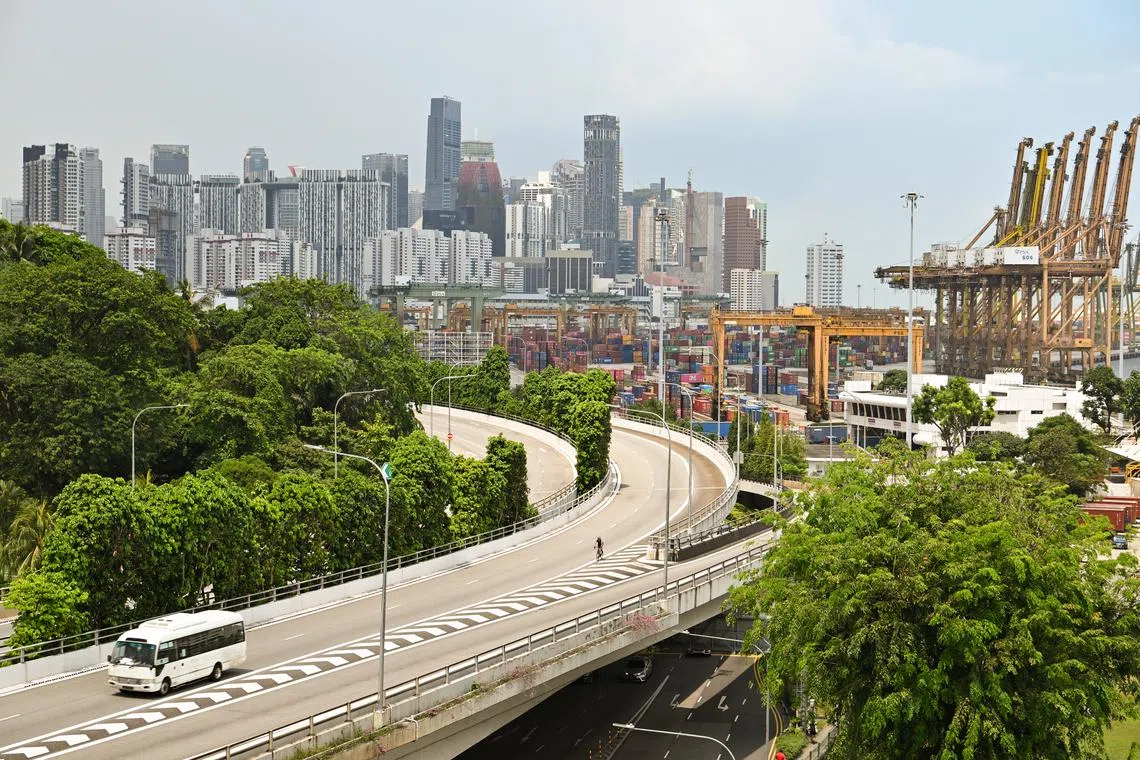Singapore economy to expand 1% to 3% in 2024 as exports improve; 2023 growth forecast at 1%
Sign up now: Get ST's newsletters delivered to your inbox

Trade-related sectors should see a modest improvement in 2024, the Ministry of Trade and Industry said.
ST PHOTO: LIM YAOHUI
Follow topic:
SINGAPORE – Singapore’s economy is expected to grow between 1 per cent and 3 per cent in 2024 as trade-related sectors improve modestly, the Ministry of Trade and Industry (MTI) said on Nov 22.
Growth in 2023 will come in at around 1 per cent amid weak export demand, MTI said in its latest quarterly economic survey report.
The forecast was narrowed from the range of 0.5 per cent to 1.5 per cent announced in August,
MTI also said that gross domestic product grew 1.1 per cent year on year in the third quarter, a faster pace than the 0.5 per cent in the second quarter and the 0.4 per cent in the first three months of 2023. The growth rate was also better than MTI’s advance estimate of 0.7 per cent.
Analysts said a better-than-expected outcome in the third quarter could be a sign of stabilisation after anaemic growth in the first half. It may also herald a potential recovery onwards into 2024.
On a quarter-on-quarter seasonally adjusted basis, the economy grew 1.4 per cent, accelerating from the 0.1 per cent expansion in the second quarter.
Growth in the July-August period was aided by the ongoing recovery in air travel and inbound tourism,
Still, the cumulative effects of higher interest rates and a slower-than-expected Chinese economy have kept overall growth depressed.
DBS Bank economist Chua Han Teng said the surprise third-quarter gross domestic product (GDP) uptick is in line with improving business sentiments.
“For the important electronics cluster, Singapore firms anticipate better business conditions from the modest turnaround in global semiconductor sales, following the inventory digestion, even as they are cognisant of lingering geopolitical risks that could still disrupt supply chains,” he said.
Looking ahead to 2024, MTI said GDP growth rates in major economies such as the United States and euro zone are projected to slow further in the first half of next year due to continued tight financial conditions, before picking up gradually in the second half.
This, alongside a normalisation of inventory levels, is likely to support a turnaround in global manufacturing activity over the course of the year. In particular, global electronics demand is projected to recover, which will bolster the growth of most regional economies, MTI said.
“Against this backdrop, the growth prospects of the manufacturing and trade-related sectors in Singapore, such as electronics, precision engineering and wholesale trade, are expected to improve in tandem with the turnaround in global electronics demand,” said Mr Gabriel Lim, MTI’s Permanent Secretary for Policy.
Meanwhile, the finance and insurance sector is forecast to post a modest recovery as global interest rates moderate, he added.
Enterprise Singapore on Nov 22 predicted a modest recovery for key exports in 2024
It now expects key non-oil domestic exports (Nodx) to shrink by 12 per cent to 12.5 per cent in 2023, compared with August’s forecast of a 9 per cent to 10 per cent contraction.
For 2024, Nodx is projected to rise by 2 per cent to 4 per cent in tandem with the expected turnaround in global electronics demand.
Mr Barnabas Gan, acting chief economist at RHB Bank, said the relatively buoyant outlook for the Singapore economy is backed by continued improvement in growth-related momentum globally and across Asean economies.
He said global central banks are approaching their peak interest rate objectives, which means rate cuts in the second half of 2024 may be on the table. Meanwhile, there is hope for China to see a better economic prognosis in the coming quarters, which will support global semiconductor demand.
“We expect the growth momentum seen in Singapore’s externally facing sectors, namely industrial production and exports, to persist into 2024. Beyond that, we do not see evidence of a recession in global and Asean-centric numbers for the coming year,” Mr Gan said.
MTI’s Mr Lim warned that significant downside risks in the global economy remain.
Core inflation in advanced economies – which excludes volatile food and energy costs – could induce central banks to maintain current high interest rates for longer. Also, an escalation or a widening of the Israel-Hamas conflict or the war in Ukraine could lead to renewed supply disruptions and commodity price shocks.
The confluence of these factors could weigh on both business and consumer sentiments along with demand, leading to a slowdown in global growth and trade, Mr Lim said.
Mr Edward Robinson, chief economist at the Monetary Authority of Singapore (MAS), said the central bank maintains its forecast for inflation for 2024 even as economic growth is likely to improve.
He said Singapore’s core inflation, which excludes accommodation and private transport costs, is projected to come in at around 4 per cent in 2023, unchanged from 2022. For 2024, the forecast remains at the 2.5 per cent to 3.5 per cent range.
Mr Robinson also reiterated that MAS’ current policy stance remains appropriate.
In the third quarter of 2023, the manufacturing sector shrank by 4.6 per cent year on year, compared with the 7.6 per cent contraction in the previous quarter. All clusters within the sector contracted except for transport engineering.
The construction sector grew 6.3 per cent, extending the 7.7 per cent expansion in the second quarter, as both public- and private-sector construction output rose.
Growth in the information and communications sector eased to 5.6 per cent, from 7 per cent in the second quarter. The real estate sector grew 3.4 per cent, slowing from the 12.1 per cent expansion in the second quarter.


